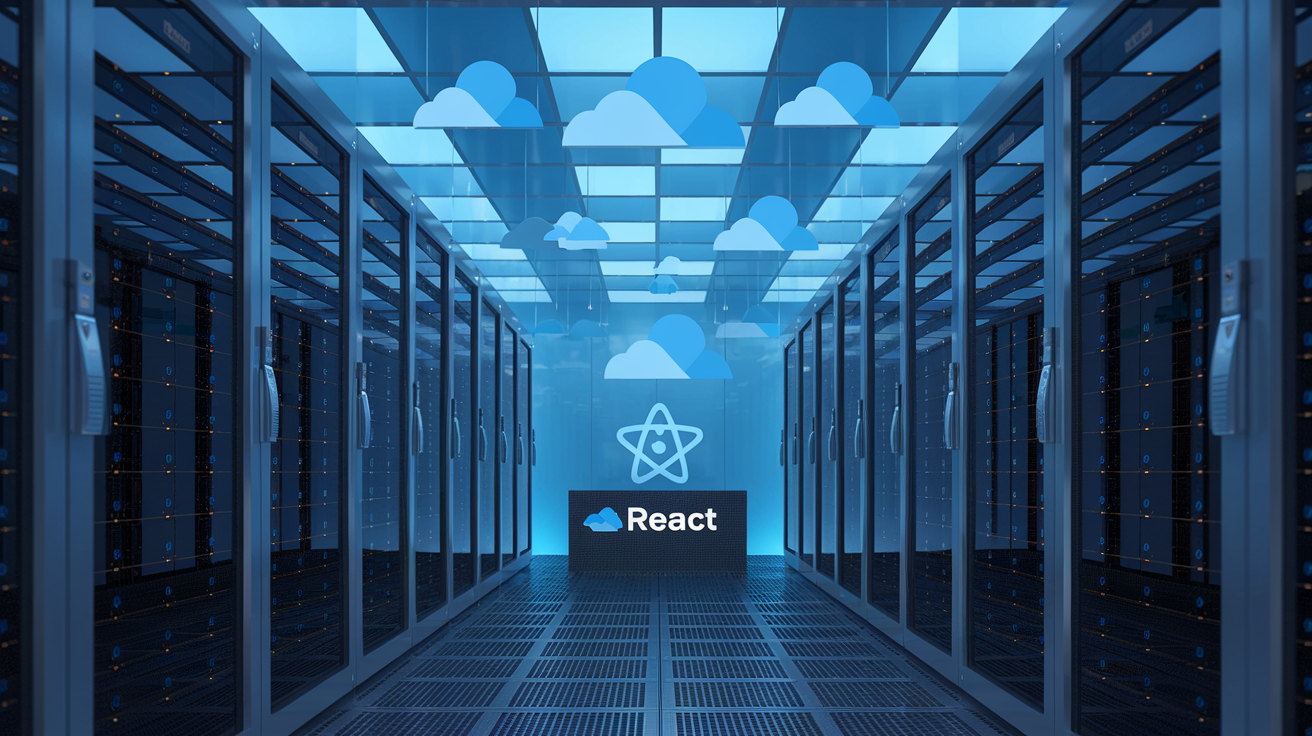Ever wondered if your React application deployment is more complex than it needs to be? Most developers spend hours configuring servers when they could be building features instead.
That stops today. Deploying React apps on Azure as serverless applications isn’t just for the infrastructure wizards anymore – it’s for anyone who wants their app running smoothly without babysitting servers.
You’re about to discover how to deploy a React web application on Azure using a serverless approach that eliminates infrastructure headaches while scaling automatically with your traffic.
The best part? You won’t need to SSH into a server at 2 AM when something breaks. But before I show you the step-by-step process that’s saved our team countless hours, let me ask you this: what could you build if deployment was the easiest part of your day?
Understanding Serverless Architecture on Azure

What makes an application “serverless”
Serverless doesn’t actually mean “no servers” – it means you don’t worry about them. In a serverless model, you focus solely on your code while the cloud provider handles all the infrastructure management. Your application runs in stateless compute containers that spring to life when triggered and disappear when the job’s done.
The key aspects that make an app truly serverless:
- Zero server management
- Pay-per-execution billing (not for idle time)
- Auto-scaling based on demand
- Built-in high availability
Think of it like using electricity at home – you just plug in devices and pay for what you use, without worrying about power plant operations.
Benefits of serverless for React applications
React apps and serverless are a match made in heaven. Here’s why:
- Simplified deployment: Push your code and it’s live – no VM configuration needed
- Cost efficiency: Pay only when users interact with your app
- Focus on frontend: Developers can concentrate on UI/UX without backend headaches
- Instant scaling: Handle traffic spikes effortlessly during product launches
- Reduced time-to-market: Ship features faster with less infrastructure overhead
Azure’s serverless offerings explained
Azure provides multiple serverless options for React applications:
- Azure Static Web Apps: The simplest path for React deployment with built-in GitHub Actions for CI/CD
- Azure Functions: For serverless API endpoints that your React app can call
- Azure Logic Apps: Workflow automation without code
- Azure Event Grid: Event-based triggers between your app’s components
Cost advantages for developers and businesses
The financial benefits of serverless React on Azure are substantial:
- No upfront infrastructure costs
- No paying for unused capacity
- Automatic scaling optimizes costs during traffic fluctuations
- Dev resources focus on creating value, not managing servers
- Reduced operational overhead saves on IT personnel
A small business can run a professional React app for pennies per day during the validation phase, then scale seamlessly as demand grows.
Setting Up Your React Application

Creating an optimized React app for serverless deployment
Want to know the secret to a smooth Azure serverless deployment? It starts with an optimized React app. First, create your app using Create React App or Next.js:
npx create-react-app azure-serverless-app
# or
npx create-next-app azure-serverless-app
Then optimize your build by removing unnecessary dependencies. Serverless deployments thrive on lightweight bundles. Audit your packages:
npm audit
npm prune --production
Your build process needs tweaking too. Add this to your package.json:
"scripts": {
"build": "react-scripts build && npm run optimize",
"optimize": "gzip -9 -r build/"
}
Essential configurations for Azure compatibility
Azure has some specific requirements your React app needs to meet. Create a staticwebapp.config.json in your project root:
{
"routes": [
{
"route": "/api/*",
"methods": ["GET", "POST"],
"rewrite": "/api/index"
},
{
"route": "/*",
"serve": "/index.html",
"statusCode": 200
}
]
}
This handles SPA routing and API connections. Also, update your public/web.config file to properly handle HTTP requests:
<configuration>
<system.webServer>
<rewrite>
<rules>
<rule name="React Routes" stopProcessing="true">
<match url=".*" />
<conditions logicalGrouping="MatchAll">
<add input="{REQUEST_FILENAME}" matchType="IsFile" negate="true" />
</conditions>
<action type="Rewrite" url="/index.html" />
</rule>
</rules>
</rewrite>
</system.webServer>
</configuration>
Environment variables and secrets management
Never commit secrets to your repo! Set up environment variables properly:
- Create
.env.localfor local development - Add
.env.localto.gitignore - Use Azure’s built-in secrets management for production
For local development:
REACT_APP_API_URL=http://localhost:7071/api
In Azure, configure these through the Azure Portal or Azure CLI:
az staticwebapp secrets set --name your-app-name --setting-names REACT_APP_API_URL="https://your-function-app.azurewebsites.net/api"
Access these variables in your React code:
const apiUrl = process.env.REACT_APP_API_URL;
For sensitive values, use Azure Key Vault integration with your Static Web App for an extra security layer.
Preparing Azure Resources

A. Setting up an Azure account
Getting started with Azure is super simple. If you don’t already have an account, head over to the Azure portal and sign up. You’ll need a valid email address and a credit card, but don’t worry – Azure offers a free tier with $200 credit for the first 30 days, so you can test the waters without spending a dime.
Once you’re in, take a minute to familiarize yourself with the Azure dashboard. It might look a bit overwhelming at first, but you’ll soon get the hang of it.
B. Creating a resource group
Think of resource groups as folders for organizing all your Azure stuff. They’re essential for keeping your React app deployment neat and tidy.
To create one:
- Click on “Resource groups” in the Azure portal
- Hit the “Add” button
- Give your group a meaningful name like “react-serverless-app”
- Select a region closest to your target audience
- Click “Review + create” and then “Create”
Resource groups make it easy to manage permissions, track costs, and delete everything at once if needed.
C. Configuring Azure Static Web Apps
Azure Static Web Apps is perfect for hosting React applications. It’s built specifically for modern web apps and comes with free SSL certificates and global CDN distribution.
To set it up:
- In your resource group, click “Create”
- Search for “Static Web App” and select it
- Fill in the basics like name and region
- Connect your GitHub repository (where your React code lives)
- Select your build details:
- Build preset: React
- App location: / (or your specific folder)
- API location: api (if using Azure Functions)
- Output location: build
Azure will automatically set up GitHub Actions for CI/CD, so your app deploys whenever you push code.
D. Understanding Azure Functions for backend needs
For serverless backend operations, Azure Functions is your best friend. It lets you write just the code you need without worrying about servers.
Azure Functions works brilliantly with React apps because:
- You pay only when your code runs
- It scales automatically with traffic
- It supports multiple languages (JavaScript, TypeScript, C#)
- Integration with other Azure services is seamless
For a React app, you’ll typically use HTTP-triggered functions that respond to API requests from your frontend. These can handle everything from data processing to third-party API integrations.
E. Setting up Azure Storage for assets
For images, videos, and other static assets, Azure Storage is the way to go:
- In your resource group, create a new Storage account
- Select “StorageV2” as the account type
- Choose “Standard” performance (unless you need premium)
- Enable “Blob public access” if your assets need to be publicly available
- Create a container for your assets once the storage account is ready
After uploading your assets, you can reference them directly in your React app using the URLs provided by Azure. For better performance, consider enabling Azure CDN on your storage account to deliver assets from edge locations closest to your users.
Deployment Process Step-by-Step

A. Building your React application for production
Ready to take your React app to the cloud? First things first – you need a production-ready build. Open your terminal and run:
npm run build
This command creates a build folder with optimized files that’ll load faster than a caffeinated developer on deadline day. Your CSS is minified, JavaScript is bundled, and everything’s ready for the real world.
Not seeing the build folder? Double-check your project structure. Still having issues? Make sure your package.json includes the build script:
"scripts": {
"build": "react-scripts build"
}
B. Connecting to Azure using the CLI
Got your build? Great! Now let’s talk to Azure. If you haven’t installed the Azure CLI yet, grab it from the official site or run:
curl -sL https://aka.ms/InstallAzureCLIDeb | sudo bash
Sign in to your Azure account:
az login
A browser window will pop up. Log in with your credentials, and you’re connected!
C. Deploying your application
Time for the magic moment! Deploy your React app to Azure Static Web Apps with:
az staticwebapp create \
--name my-react-app \
--resource-group my-resource-group \
--source build \
--location "West US 2"
For automated deployments, set up GitHub Actions by connecting your repo:
az staticwebapp create \
--name my-react-app \
--resource-group my-resource-group \
--source https://github.com/yourusername/your-repo \
--location "West US 2" \
--branch main
D. Verifying your deployment
Your app is live! Azure will provide a URL like https://purple-field-0f24acf03.azurestaticapps.net. Open it in your browser.
Check for issues in the Azure portal under your Static Web App’s “Deployment” section. See failed builds? Look at the logs for clues.
To monitor your app’s performance, navigate to the “Monitoring” tab. Set up alerts if you want to know when something’s not right.
Implementing CI/CD for Your React Application

Setting up GitHub Actions workflows
Want to deploy your React app every time you push code? GitHub Actions makes this super easy. Start by creating a .github/workflows directory in your repo and add a YAML file (like azure-deploy.yml).
Here’s a simple workflow to get you started:
name: Deploy React to Azure
on:
push:
branches: [ main ]
jobs:
build-and-deploy:
runs-on: ubuntu-latest
steps:
- uses: actions/checkout@v2
- name: Set up Node.js
uses: actions/setup-node@v1
with:
node-version: '14'
- name: Install dependencies
run: npm install
- name: Build
run: npm run build
- name: Deploy to Azure
uses: azure/static-web-apps-deploy@v1
with:
azure_static_web_apps_api_token: ${{ secrets.AZURE_STATIC_WEB_APPS_API_TOKEN }}
repo_token: ${{ secrets.GITHUB_TOKEN }}
app_location: "/"
output_location: "build"
Just grab your deployment token from the Azure portal and add it to your GitHub repo secrets.
Configuring Azure DevOps pipelines
Not a GitHub fan? Azure DevOps has your back. Head to your Azure DevOps project, click on Pipelines, and create a new one.
The pipeline YAML for your React app might look like this:
trigger:
- main
pool:
vmImage: 'ubuntu-latest'
steps:
- task: NodeTool@0
inputs:
versionSpec: '14.x'
displayName: 'Install Node.js'
- script: |
npm install
npm run build
displayName: 'npm install and build'
- task: AzureStaticWebApp@0
inputs:
app_location: '/'
output_location: 'build'
azure_static_web_apps_api_token: $(AZURE_STATIC_WEB_APP_TOKEN)
Remember to add your deployment token as a pipeline variable.
Automating testing before deployment
Don’t skip testing! Add these steps to your workflow before deployment:
- name: Run tests
run: npm test -- --watchAll=false
For more confidence, add end-to-end tests with Cypress:
- name: E2E Tests
run: |
npm run build
npm run start & npx wait-on http://localhost:3000
npx cypress run
Pro tip: Configure your pipeline to create deployment previews for pull requests. This lets your team review changes before they hit production.
Optimizing Your Serverless React Application

Performance tuning for faster load times
Your serverless React app might be live, but if it loads like it’s on dial-up, users won’t stick around. First things first, minimize your bundle size using code splitting. Instead of forcing users to download your entire app upfront, serve only what they need:
const Dashboard = React.lazy(() => import('./Dashboard'));
Remove unused dependencies – that animation library you tried once? Kick it out. Optimize your images with WebP format and lazy loading.
Azure’s built-in compression helps too. Enable it in your Static Web App configuration:
{
"routes": [
{
"route": "/*",
"headers": {
"Cache-Control": "max-age=86400"
}
}
]
}
Implementing CDN for global delivery
Got users across different continents? Azure CDN is your best friend. Hook it up to your Static Web App in minutes through the Azure Portal.
The magic happens when your React app gets cached at edge locations worldwide. Someone in Tokyo? They’re getting content from a nearby server, not from your main deployment location.
Set up custom rules for different content types:
| Content Type | Cache Duration |
|---|---|
| HTML/JS | 1 hour |
| Images | 7 days |
| CSS | 3 days |
Monitoring and analytics setup
Flying blind with your serverless app? Rookie mistake. Implement Azure Application Insights with just a few lines:
import { ApplicationInsights } from '@microsoft/applicationinsights-web';
const appInsights = new ApplicationInsights({
config: {
connectionString: 'YOUR_CONNECTION_STRING'
}
});
appInsights.loadAppInsights();
Track custom events for user interactions that matter:
appInsights.trackEvent({name: "userLoggedIn", properties: {userId: "12345"}});
Set up custom dashboards to monitor key metrics like page load time, API response times, and user session duration.
Scaling strategies for high-traffic periods
The beauty of serverless? It scales automatically. But you need to help it along.
For predicted traffic spikes (like during your big marketing campaign), warm up your functions by increasing the pre-warmed instances in your hosting plan.
Implement proper caching strategies:
// In your service worker
workbox.routing.registerRoute(
/\.(?:png|jpg|jpeg|svg|gif)$/,
new workbox.strategies.CacheFirst({
cacheName: 'images',
plugins: [
new workbox.expiration.Plugin({
maxEntries: 60,
maxAgeSeconds: 30 * 24 * 60 * 60, // 30 days
}),
],
})
);
Use Azure Front Door for intelligent routing during high-traffic periods to distribute load efficiently.
Adding Backend Functionality with Azure Functions

A. Creating your first Azure Function
Ever tried to add backend logic to your React app without spinning up a whole server? Azure Functions makes this ridiculously easy.
To create your first function:
- Head to the Azure portal and click “Create a resource” > “Function App”
- Fill in these basics:
- A unique app name
- Runtime stack (Node.js works great with React)
- Region (pick one close to your users)
After deployment, click “Create Function” and select “HTTP trigger.” This creates an endpoint that responds to HTTP requests – perfect for API calls from your React app.
The default code looks something like this:
module.exports = async function (context, req) {
const name = req.query.name || (req.body && req.body.name);
const responseMessage = name
? "Hello, " + name
: "Pass a name in the query string or request body";
context.res = {
status: 200,
body: responseMessage
};
}
Just save it, grab the function URL, and you’re ready to roll.
B. Connecting your React frontend to Azure Functions
The magic happens when your React app talks to these functions. First, get your function URL from the Azure portal – look for “Get Function URL” on your function page.
In your React app, use fetch or axios to make API calls:
// Using fetch
const fetchData = async () => {
try {
const response = await fetch('your-function-url');
const data = await response.json();
setResults(data);
} catch (error) {
console.error('Error:', error);
}
};
Pro tip: Store your function URL in environment variables:
// .env file
REACT_APP_API_URL=https://your-function-app.azurewebsites.net/api/yourfunction
This keeps your endpoints configurable between environments without code changes.
C. Handling API requests efficiently
API calls can make or break your app’s performance. Here’s how to keep things snappy:
-
Implement caching: Store responses for frequently accessed data.
const cachedData = {}; const getData = async (key) => { if (cachedData[key] && cachedData[key].expiry > Date.now()) { return cachedData[key].data; } const response = await fetch(`${process.env.REACT_APP_API_URL}/${key}`); const data = await response.json(); cachedData[key] = { data, expiry: Date.now() + 300000 // 5 minutes }; return data; }; -
Batch related requests: Instead of multiple API calls, design your functions to return related data together.
-
Add loading states: Always show users something is happening.
D. Implementing authentication and authorization
Nobody wants unauthorized users poking around their API. Azure Functions integrates beautifully with Azure AD and other auth providers.
For simple API keys:
module.exports = async function (context, req) {
const apiKey = req.headers['x-api-key'];
if (!apiKey || apiKey !== process.env.API_KEY) {
context.res = {
status: 401,
body: "Unauthorized"
};
return;
}
// Continue with authorized function logic
};
For more robust auth, use Easy Auth in Azure or implement Azure AD authentication:
- Configure authentication in your Function App settings
- Access user claims in your function code
- In React, handle login flows with MSAL.js or similar libraries
This serverless approach means you’re only paying for what you use – no more overprovisioned servers collecting dust.
Troubleshooting Common Deployment Issues

A. Resolving build failures
Ever deployed your React app to Azure only to hit that dreaded build failure? Been there. The most common culprits are:
- Dependency issues: Your package.json might have conflicts or missing dependencies. Run
npm installlocally first to verify everything works.
# Check for outdated packages
npm outdated
# Force a clean install
rm -rf node_modules
npm cache clean --force
npm install
-
Node version mismatches: Azure might be using a different Node version than your local setup. Specify your Node version in the build configuration settings.
-
Environment variables: Missing environment variables can cause silent build failures. Double-check your application settings in the Azure portal match what your app expects.
B. Fixing routing problems
Routing issues can make you want to throw your computer out the window. Here’s how to fix them:
- Add a
web.configorroutes.jsonfile to handle client-side routing - For Azure Static Web Apps, create a
staticwebapp.config.jsonwith:
{
"navigationFallback": {
"rewrite": "/index.html",
"exclude": ["/images/*.{png,jpg,gif}", "/css/*"]
}
}
- Test your routes locally with the Azure Static Web Apps CLI before deploying
C. Debugging API connection issues
API connections not working? Check these common issues:
- CORS settings: Ensure your API allows requests from your frontend domain
- Authentication tokens: Verify tokens are being sent correctly in request headers
- Connection strings: Make sure API connection details are correctly configured in your application settings
- Network issues: Use the browser’s Network tab to inspect request/response cycles
D. Addressing performance bottlenecks
Your app’s running like a turtle? Try these fixes:
- Enable Azure CDN to distribute static assets globally
- Implement code-splitting to reduce initial bundle size
- Use Azure Application Insights to identify specific performance issues
- Consider scaling up your Azure service plan during high traffic periods
- Optimize API calls by implementing caching strategies

Deploying a React application using Azure’s serverless architecture streamlines the development process while reducing operational overhead. By following the steps outlined in this guide, you’ve learned how to set up your React application, prepare the necessary Azure resources, implement a robust CI/CD pipeline, and optimize your application for performance. You’ve also discovered how to enhance your application with backend functionality using Azure Functions and overcome common deployment challenges.
Take your serverless journey to the next level by continuing to explore Azure’s extensive ecosystem. Start small, monitor your application’s performance, and scale as needed. Remember that serverless architecture offers significant cost benefits and allows you to focus more on developing features that add value to your users rather than managing infrastructure. Your React application is now positioned to grow alongside your business needs with minimal operational concerns.



















